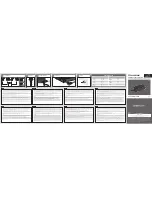
4
Range Planning
On floor-plan drawings, draw 100 feet (30m) diameter circles around the
location of each controller to identify optimal transmitter locations. Refer to
the table below for range considerations with building materials that reduce the
radio signal power.
Use an EPM300C for on-site range testing and location suitability. The EPM300C
provides the convenience of a hand-held device indicating signal strength from
transmitters. The EPM300C will verify proper signal reception at your intended
controller locations.
Material
Attenuation
Material
Range-typical
Wood
0 - 10%
Line of Site
100’ (30m) corridors
Plaster
0 - 10%
Line of Site
330’ (100m)open halls
Glass
0 - 10%
Plasterboard
100’ (30m) through 5 walls
Brick
5 - 35%
Brick
65’ (20m) through 3 walls
MDF
5 - 35%
FerroConcrete 33’ (10m)
Ferroconcrete
10 - 90%
Ceiling
Not Reccomended
Metal
90 - 100%
Aluminum
90 - 100%
Signal Attenuation
The radio signal is attenuated by the materials that it passes through. Dense
materials require more power to pass a radio signal consuming more of the
signal strength and reducing the signal range.
Mounting the Sensor
You can use double sided tape or wall anchors and screws to mount the
MOS sensor.
1. Using a fingernail, insert under the clear plastic lens at one of the relief tabs
in the base plate and pull up.
2. You will need to repeat with at least two tabs until the lens pops free.
3. Hold the sensor in place and mark the two mounting holes with a pencil.
4. Install the wall anchors and screws per the package instructions leaving the
screws loose.
5. Place the MOS sensor so the screw heads go through the mounting holes
and slide the sensor so the screw head is holding the base plate.
6. Tighten the screws, do not over tighten.
7. Replace the lens over the sensor aligning the link button hole with the
button and press in place.


























